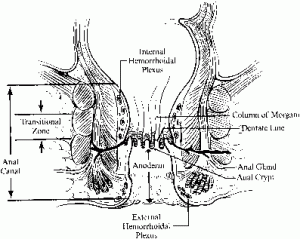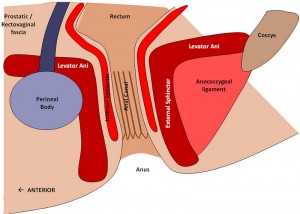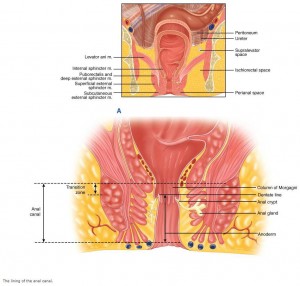What is Anal Canal?
It is the last section of the large intestine. It is the last spot where stools pass through before finally exiting the body.
Anal Canal Location
It is located in a position between the rectum and the anus, under the level of the pelvic diaphragm. It is situated in the anal triangle of the perineum, between the left and right ischioanal fossa.
Anal Canal Anatomy
It is about 1-1.5 inches long. It has a narrower diameter than that of the rectum to which it is joined. It is encircled by a muscle called sphincter, which controls intestinal movements. The opening and closing of this canal are regulated by this muscle. The organ is technically separated into three prominent sections. These include the Zona columnaris, which accounts for the upper half of the canal. It is lined with the tissue that can also be found in the stomach, small intestine and the large intestine. The bottom half of the canal consists of the Zona hemorrhagica and the Zona cutanea. Both these lower sections comprise of tissues that are different from the zona columnaris. This includes the tissue that can be usually seen in more exposed areas of the skin, such as the lips.
Anal Canal Function
It serves to lubricate and transmit fecal matter as it passes from the rectum to outside the body. It helps regulate defecation and maintain continence (voluntary control over fecal discharge).
Anal Canal Problems
Quite a few problems can affect this organ. These include:
- Hemorrhoids – This is a common problem affecting the anal canal. Hemorrhoids are swollen veins that can cause discomfort and itching. These may remain inside the canal but pop out during defecation. In some patients, these can fall out or prolapse into the anus. The veins are often found to bleed in more acute cases of the condition. Hemorrhoids, even small ones, can cause greater discomfort when feces are present inside the canal. Although minor hemorrhoids generally go away with lifestyle changes, severe ones have to be cured by surgery or medications.
- Fissures – These are small tears (or ruptures) in the canal and often cause much pain. These usually worsen due to contracting and expansion of the anal sphincter.
- Fistulas – These are abnormal passages or tracts that develop in the skin due to an infection.
- Abscesses – These are infected bumps that can easily develop from a fistula.
In rare cases, cancerous conditions may develop in the canal. Cancers in the anal canal account for approximately 2% of all gastrointestinal tract cancers. These occur equally in both men and women. Although less common than colon cancer, which is hundred times more fatal, cancer disorders in the anal passage are the cause of around 600 deaths every year in the U.S. Fortunately, the canal can easily be accessed from outside. Naturally, problems or changes in the region can readily be detected. It is also easier for doctors to treat the region, particularly through surgery.
Anal Canal Pictures
Here are some useful Anal Canal images and illustrations that will help you know how this important organ looks like. You may use these Anal Canal photos for reference.
References:
http://emedicine.medscape.com/article/1990236-overview
http://www.britannica.com/EBchecked/topic/22378/anal-canal
http://www.cancer.org/Cancer/AnalCancer/DetailedGuide/anal-cancer-what-is-anal-cancer




No comments yet.